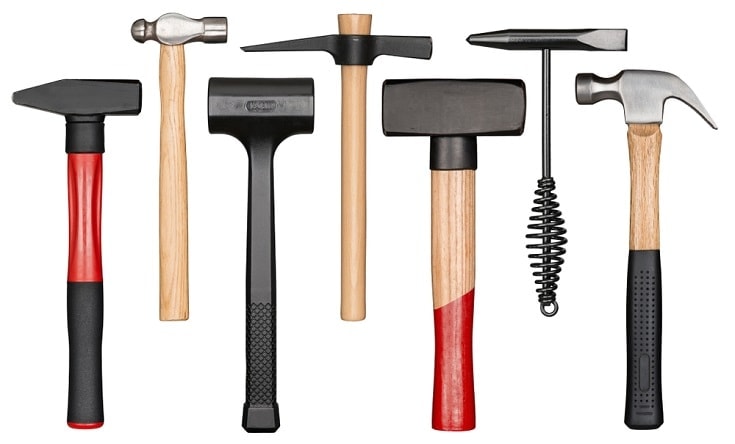Dead Blow Hammer vs Rubber Mallet: What’s the Difference?
-
- Last updated:


When you need to hit something with force, a hammer is the perfect tool. However, if you also need to avoid damaging the item you’re hitting, a hammer is no longer such a great option. The metal head on a hammer can cause some damage, especially with so much force behind it.
You need something a bit softer, like a dead blow hammer or a rubber mallet. Neither will damage the object you’re hitting like a hammer would. But which one should you choose? Is there even a difference between them?
While they are similar tools, stark differences separate a dead blow hammer from a rubber mallet. Those differences mean that sometimes one is the clear choice while the other is less than optimal. We’ll explore their differences so that you’ll get a better understanding of both tools and their uses.

Overview of Dead Blow Hammer:

A dead blow hammer is a type of mallet made from a soft compound such as rubber, but it’s not a rubber mallet. It is much heavier and has some unique characteristics that set it apart from all other types of hammers. Since a dead blow hammer is covered in soft rubber, it won’t damage or mar any surface you’re hitting like a metal hammer would. So far, it sounds pretty similar to a rubber mallet, but rubber tends to bounce, which isn’t always desirable.
What’s Inside a Dead Blow Hammer?
While a dead blow hammer is mostly made of rubber, the head is filled with something else. Inside the head, it’s hollow, and the space is filled with a medium, usually sand, lead shot, or steel shot. This adds extra weight, but it’s meant to increase the force. When you swing a dead blow hammer, the sand or shot inside will all shift to the front, transferring the energy into the object you’re hitting.
Dead Blow Means No Bounce
The defining characteristic of a dead blow hammer is that it doesn’t bounce. When you hit something with it, all of the shot or sand being thrown to the front prevents any rebound from occurring. This means you get the non-marring benefits of a rubber mallet with a lot of extra power, allowing you to move objects and strike with force without worrying about the mallet rebounding back at you.
- Hits with greater force
- Doesn’t bounce
- Won’t damage or mar
- Not very precise

Overview of Rubber Mallet:
It’s pretty easy to tell a rubber mallet and a dead blow hammer apart by their appearance. But since they’re both mallets made of rubber, it can be a bit more confusing trying to figure out the differences in their usage.
As the name suggests, a rubber mallet is made of rubber. Well, the head is made of rubber. The handle is usually made of wood. Unlike a dead blow hammer, there’s nothing inside the head of a rubber mallet. It’s just solid rubber all the way through.

Rubber is Soft
The rubber head on a rubber mallet is soft, especially when compared to a metal hammer. You won’t damage the surface you’re hitting with a rubber mallet. Since the head on a rubber mallet is all rubber with no filler, these mallets are very light. You’ll get less impact force with a rubber mallet, which is great when you are trying to avoid cutting too deep with a chisel or something similar.
Watch Out for the Bounce
But the flip side to that soft rubber head is that it creates quite a bit of bounce. Whenever you strike something with a rubber mallet, it will rebound with a similar force. If you’re working in a tight space, this could cause you to hit something that you didn’t intend to accidentally. It could rebound back and hit you even if you’re not in a tight space!
This is the main difference between a dead blow hammer and a rubber mallet. A rubber mallet hits with less force and rebounds. A dead blow hammer hits with greater force and won’t bounce back.
- Won’t damage or mar
- Very lightweight
- Will rebound when you strike
- Doesn’t hit with much force
- Lacks precision

Neither is Precise

While both of these mallets are great for their intended purpose, it should be noted that neither is a precise instrument. The heads on both of these tools are rather large. If you need to hit something small with precision and still want to avoid damaging it, neither of these mallets is practical. In such cases, you’re probably better off with a soft-face hammer.
Application of Force
One of the primary differences separating dead blow hammers from rubber mallets is the force behind each swing. Rubber mallets are very light, and the entire head is rubber. When you swing it, you won’t get much force behind the impact, but a dead blow hammer weighs considerably more. Plus, the shot or sand in the head multiplies the impact force. You can get the non-damaging benefits of a rubber head while hitting with a force similar to a mini sledgehammer.
To Bounce or Not to Bounce
The other big difference between these two tools is the rebound. When you strike with a dead blow hammer, there is no rebound. The force is all transferred to the object you’re hitting. But that’s not the case with a rubber mallet, which will bounce back with a similar force to your initial swing. If you strike hard, a rubber mallet will rebound nearly as hard. When this happens, it could hit the user, or it could even cause unintentional damage elsewhere.
Which Mallet Should You Use?
Both of these tools allow you to hit materials or surfaces without damaging them. How much force you need to apply and how much space you have to work in will usually determine the best tool.
A dead blow hammer is best if you need to hit with serious force. When working in tight spaces, around sensitive objects, or you need to hit something hard, you won’t want to use a rubber mallet since it will rebound when you strike with it. So, a dead blow hammer is still the ideal tool.
However, if you’re trying to avoid striking with too much force, like when using a chisel or a cutting tool, a rubber mallet is the superior choice.

Dead Blow Hammer vs Rubber Mallet – In Conclusion
There are moments when you could use a dead blow hammer or rubber mallet. However, in most situations, one will be a better choice than the other. Ideally, you’ll have both on hand, so you’re prepared for anything! Neither will damage the surface you’re striking. So, figure out how much force you need to apply and whether a rebound is acceptable, and you’ll know exactly which tool to use.
Featured Image Credit: StockSnap, Pixabay
Contents

